Ulcer Index and Ulcer Performance Index
Last updated
05/28/2014
Ulcer Index and UPI serve two different purposes. Both measure sickening
drops. Use UI with an mix of securities to determine which is the most likely to
give you an ulcer. Use UPI to rate a group of related securities (like the
GROWTH family of funds) when compared to a the
low basis risk return. UPI is a relative
rating comparing another issue selected in the Parameters Dialog.
Ulcer Index (UI)
The Ulcer Index is a measurement of day- to-day drops. It doesn't matter if
an issue gains back all of its losses, the fact that it takes sickening dips is
all that counts in the UI calculation. In the chart below, which of the issues
would be the mostly likely to upset your stomach?
|
|
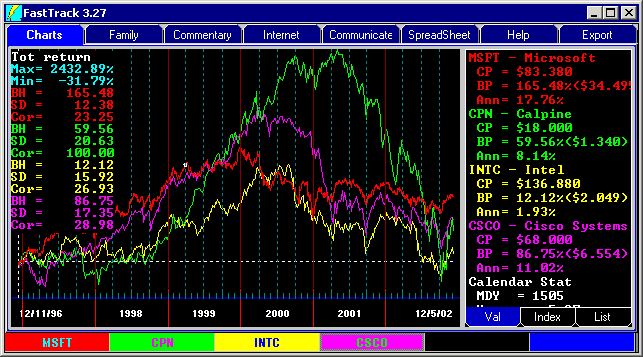
Surprisingly, its not the green highest SD= value, Calpine. CSCO is the loser with
the highest UI. While CPN presents one big stomach ache, CSCO disappoints again and again.
Our subjective interpretation: To play CSCO profitably, you will have to trade more often and more
quickly and your percent of losing trades will likely be greater.
|
|
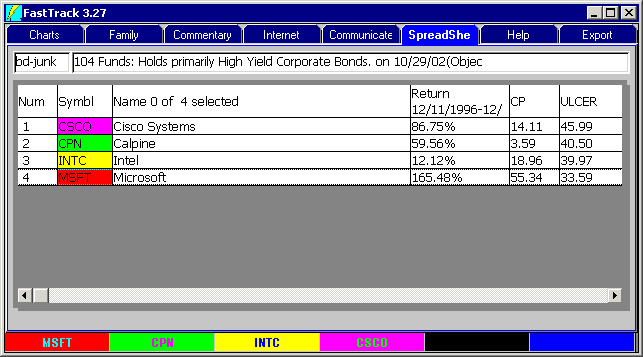
|
Ulcer Performance Index (UPI)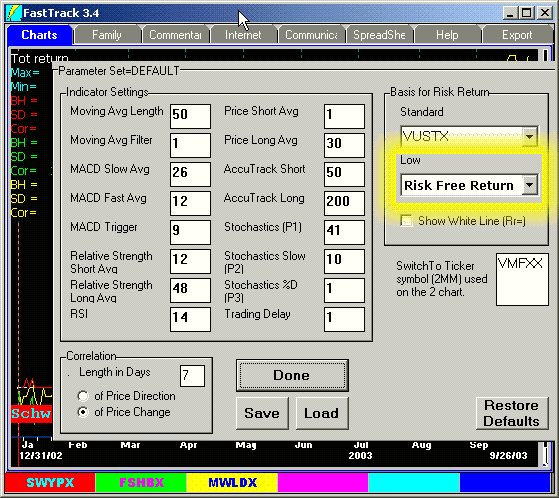
Unlike the Ulcer Index. UPI is a function not only of the issue being
measured but also its performance with respect to another issue.
Traditional calculation of UPI uses " Risk Free Return" (RFR) in
UPI calculation. RFR is selectable in the Low Basis for Risk Return
options FT defines RFR as the constant rate
of return using the ranked period's last price of IRX-X
(90-day treasury,short-term interest rates). IRX-X is an index in the Funds
database.
HOWEVER, RFR has become unusable since it dropped to near 0% in the
2008 financial crisis. See discussion below.
|
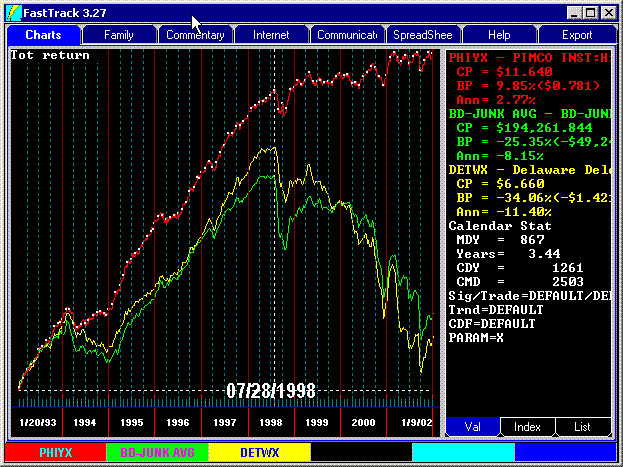 When Issues Ranked have a Common Investment Objective When Issues Ranked have a Common Investment Objective
FT is not limited to using only RFR in the UPI calculation.
For example, if you wanted to hold part of your portfolio in Junk
bonds, then you might use UPI to determine which Bond fund in the BD-JUNK family
had did the best job managing the downside risk.
To make this decision easier, the best way to use UPI would be to
- Set the Low Basis for Risk Return to BD-JUNK AVG, that is, the average
junk bond.
- Save this average as an FNU.
- Set the spreadsheet to have a UPI column.
- Load the BD-JUNK family into the spreadsheet.
- Sort by UPI with the highest positive value at the top.
|
|
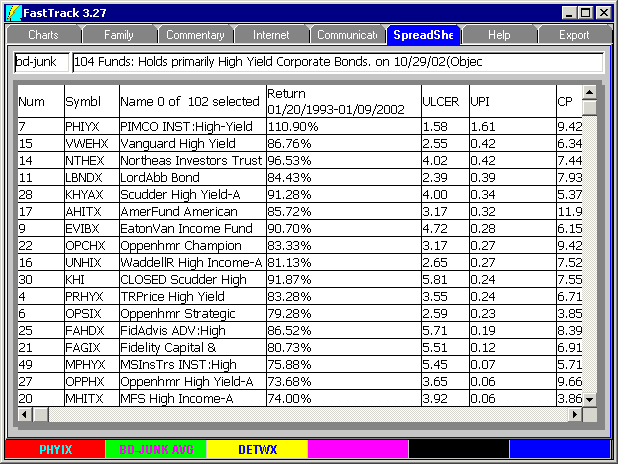 What you see is that PHYIX has the highest (best) UPI. When we compare the red PHIYX
to the average junk bond in green, we can clearly see the outstanding management
of fund. In contrast, the lowest (worst) UPI belonged to DETWX. Issue
with a UPI near zero would have very nearly the same risk/return as the
Low Risk Basis selected in parameters. What you see is that PHYIX has the highest (best) UPI. When we compare the red PHIYX
to the average junk bond in green, we can clearly see the outstanding management
of fund. In contrast, the lowest (worst) UPI belonged to DETWX. Issue
with a UPI near zero would have very nearly the same risk/return as the
Low Risk Basis selected in parameters.
Note: When the UI, which is a divisor in the UPI computation, is very near to
zero then UPI is arbitrarily set to 9999.99. This would indicate the best
possible result. UI=0 and UPI =9999.99 means that there were nil drawdowns for the period.
|
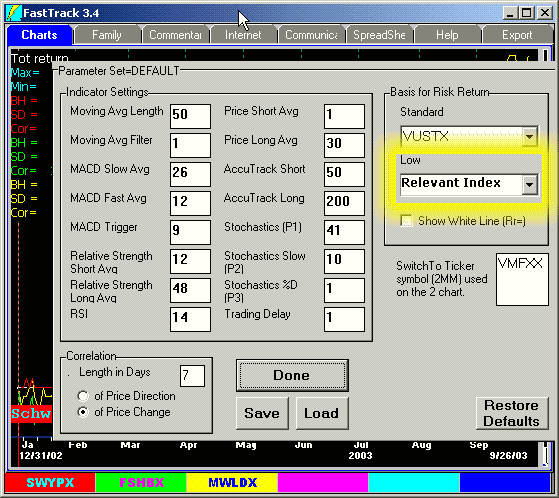 When Ranked Issues DO NOT have a Common Investment Objective When Ranked Issues DO NOT have a Common Investment Objective
Doing a UPI calculation on a families like the entire Fidelity Family of funds
would produce a wide range of UPI's. In general, where issues are not highly
correlated, use UI, not UPI to compare the issues.
However, if the goal is to evaluate each Fidelity fund with respect to each fund's
objective peers from other fund families, then choose Relevant Index.
The Parameters Dialog allows selection of Relevant Index
as the Low Basis for Risk Return . In this
case, the Low Risk Basis issue for the UPI changes for each Fidelity fund. For issues
with
no Relevant Index (UPI = NA). The high ranked UPI issues are the winners in their respective objectives, and NOT necessarily winners in the
Fidelity family.
|
Seemingly Odd UPI order
UPI is a function of return, Ulcer index, and selected Low Basis.
- If you choose, a Low Basis with a high return , then most everything
else will have a negative UPI because it's return is lower than the
Low Risk Basis . . . the Ulcer Index component becomes irrelevant.
- If you choose, a Low Basis with no volatility (like a money market
fund), then the Ulcer Index component of UPI will be 0% and the UPI
calculation will yield -99999, a division by zero error.
As noted immediately above. Don't use UPI on a mix of different types of
issues (not highly correlated), OR, at least, choose one of the lower return
issues to set as the Low Risk Basis.
|



 When Issues Ranked have a Common Investment Objective
When Issues Ranked have a Common Investment Objective What you see is that PHYIX has the highest (best) UPI. When we compare the red PHIYX
to the average junk bond in green, we can clearly see the outstanding management
of fund. In contrast, the lowest (worst) UPI belonged to DETWX. Issue
with a UPI near zero would have very nearly the same risk/return as the
What you see is that PHYIX has the highest (best) UPI. When we compare the red PHIYX
to the average junk bond in green, we can clearly see the outstanding management
of fund. In contrast, the lowest (worst) UPI belonged to DETWX. Issue
with a UPI near zero would have very nearly the same risk/return as the
 When Ranked Issues DO NOT have a Common Investment Objective
When Ranked Issues DO NOT have a Common Investment Objective